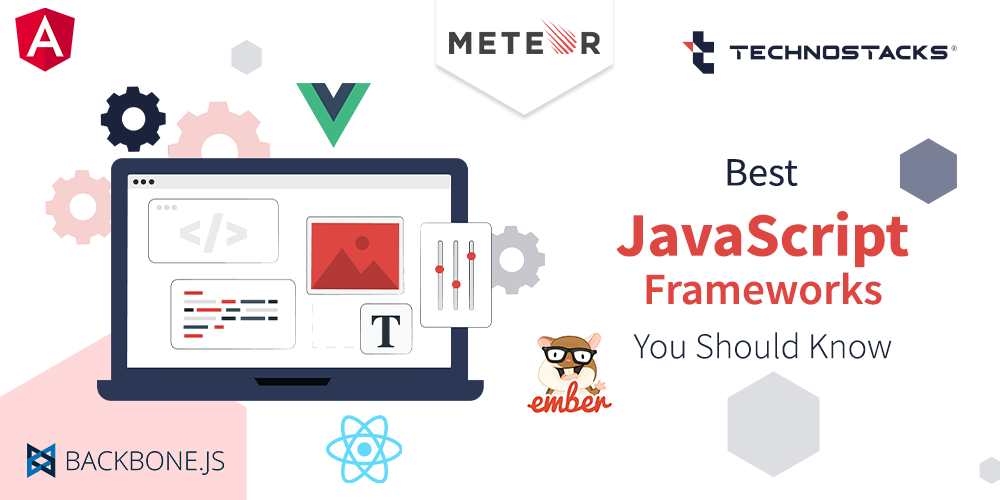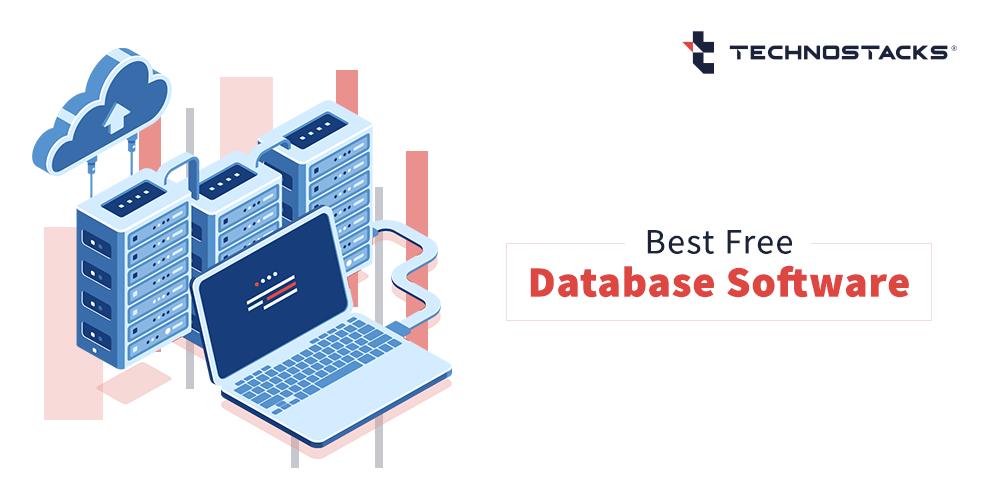17 Best JavaScript Frameworks For Robust Web Development
There are a number of the best JavaScript frameworks available for web developers with diverse pros and cons.
JavaScript Frameworks give JavaScript developers the basic foundation needed for developing JavaScript applications. This saves JavaScript developers the stress of beginning from scratch by using an operational base to get things going.
JavaScript is the most popular multi-paradigm language that encourages functional, event-driven, and robust (including object-oriented and prototype-based) programming styles.
JavaScript was used initially only for the client-side. However, nowadays, JavaScript is utilized as a server-side programming language as well. To sum up, in just a single sentence – JavaScript is the language of the web.
We will see here the guide to both back-end and front-end best JavaScript frameworks.
What Is a JavaScript Framework?
The collection of pre-written JS codes will help you perform common tasks faster, making JavaScript coding easier, especially for novice developers.
In JavaScript Frameworks, this base holds a collection of JavaScript code libraries. The libraries compile code that extracts particular functionality for the specific sort of app you may be working on.
In reality, the JavaScript framework will determine the structure of the complete application.
What Does a JavaScript Framework Do?
Every JavaScript framework assists a particular purpose. JavaScript is a durable option for web development, and several of its framework’s spin around this undertaking.
Building web apps and websites from origin to end can take quite a bit of work. Web frameworks – or JavaScript frameworks – profit because each website and web app has regular features.
In this method, you can study the term framework quite literally. Businesses also rely on JavaScript frameworks as a design for the overall assistance and shape of an outer framing. Software frameworks do the same.
JavaScript frameworks contribute pre-written JavaScript code that provides standard programming features, finally easing development.
Best Javascript Frameworks for 2025
We have listed the most popular frameworks you can use for your future projects below, along with their pros and cons for better understanding.
Let us see the most used JavaScript Frameworks available in the market. This list of JavaScript frameworks is prepared by the research, forum analysis, and expert developer’s reviews.
1. React JS
React JS is an open-source and best JavaScript Framework generally used to create responsive and active user interfaces (UI). It is apprehended to be SEO-friendly and hence is favored by developers who build e-commerce websites.React.js development is most ideal when a superior performing enterprise app is required to be delivered to its user-base. User interfaces like Instagram and Facebook empower it.
Key features
Virtual Document Object Model (DOM)
One-way data-binding only
Made up of various elements that can be reused
Cross-platform performance
Pros
- Very simple to learn and use
- It comes with a set of efficient tools
- Helps with performance enhancement
- Smaller in size
- Ability to test and debug quickly
Cons
- Regular upgrades need developers to sustain recent learning changes
- It is not a comprehensive technology. It needs to be used with other F/Ms.
2. Vue JS
Vue JS is another one of the best JavaScript frameworks generally used in developing cross-platform apps and websites. It also supports the build of powerful Single Page Applications (SPAs). Vue.js offers a simple and swift fix for apps, user interface, and engaging web-based interface development. It can empower modern-day single-page web-based apps.
Key features
Cost-effective virtual DOM view option
It comes with a built-in component that helps with CSS transitions and animations
Precise two-way data binding preferences
Easy to understand and learn
Pros
Simple to integrate
Small in size
Offers two-way communication
Flexible framework
Cons
Lack of essential plugins
Not suitable for extensive scaling
Has language barriers
Too flexible for good
3. Angular
It is one of the most powerful and best JS Frameworks in 2025. Here are the top characteristics of Angular. It enables transmission of all the contents right from the server to the precise browser and helps in arranging all the created web pages concurrently. Angular has a precise NativeScript for native applications while facilitating an Ionic framework for hybrid-based apps. AngularJS is a cross-platform framework. The code of the framework is entirely clean, easy to comprehend and comprises very less frequency of errors through its precise controller and data rendering technique.
Key features
Ability to offer high-performance, progressive web pages
Can work across multiple operating systems
It provides an instinctive and progressive API
Aptitude to get smart code at the ends
Provides immediate error discovery and feedback selections
Pros
Flawless synchronization amid view and model
Alterations are promptly showcased right in the view
Capability to isolate out the view and data sets
Cons
More complex F/M to learn
The developer needs to learn MVC
Heavier framework
4. Ember JS
Ember JS is another commonly used JavaScript framework for front-end that helps create scalable SPAs (Single Page Applications). Ember can be used to develop frameworks for the web, mobile, and desktop versions. Ember has a precise widget-based style, known as Ember components. It possesses the handlebars layout and its architecture enables developers to own the application-based HTML tags.
Key features
Large teams can easily use it
It comes with computed properties
It has larger than 1500 add-ons that only have to grow with time
Reusable and easy to maintain too
Pros
Seamless URL support
Offers client-rendering services
Well-blended data layers
Minimizes DOM
Cons
Slightly more complicated to learn
Very opinionated
Not very fast and efficient
5. Node.js
Released in 2009, Node.js, among the most popular JavaScript frameworks, is an open-source runtime framework designed to run JavaScript browser-free and is distinct from other front-end-focused frameworks listed. It is intended to create network-based applications on a large scale; to achieve this; Node is optimized for efficient management of resources. It is also compatible with other libraries, frameworks.
Key Features
All APIs in the Node.js library work asynchronously, which means they are non-blocking. After calling an API, the server will move to the next one. An Event notification mechanism of Node.js allows the server to receive a response from the previous API call.
Node.js library, built on Google Chrome’s V8 JavaScript Engine, is extremely fast in code execution.
Node.js has a single-threaded model that uses event looping. The server responds in a non-blocking manner using the event mechanism. This contrasts with traditional servers with limited threads for handling requests.
Node.js apps never buffer data. These applications output data in chunks.
Pros
Easy to use and easily integrated with other applications.
Capability to increase the scale by the requirements
Non-blocking and non-blocking thread execution
Support for handling a variety of concurrent connections
Rapid processing and an event-based model
Cons
Performance is a concern when you use a lot of computation.
A decrepit tooling system is a significant issue
Call-backs are a constant necessity that can affect the quality of code
Library support is not as strong.
This API is susceptible to several changes due to the unstable API
6. Svelte JS
Svelte JS was released in 2016 and is a free front-end JS Framework. You can create elements using Svelte JS in languages you are satisfied with (JavaScript, HTML, or CSS). There is a significant difference between those frameworks. Svelte doesn’t use Virtual DOM like React and Vue. It runs at build time and converts your components into code that runs in the browsers, whereas others do the operations in the browser itself.
Key Features
No virtual DOM
This converts codes into Vanilla JavaScript
Very reactive
Pros
Lightweight and easy to implement
Lesser boilerplate
Very easy to learn
It comes with a built-in reactive store
Cons
Not an extremely recognized framework
There is continuous requirement to explore and update
Not many such tools in the market
Smaller-sized community and ecosystem
7. Preact
Preact JS is among the smallest, fastest and most efficient JavaScript libraries that can serve as an excellent replacement for React. Preact is a streamlined version of React that has a built size, but it covers all the essential features of the modern JavaScript frameworks. Many developers utilize React to develop and then change to Preact when they are in production. With its strong community support, speedy performance, and clean code Preact JS has made a name for itself within the community.
Key Features
It’s among the fastest Virtual DOM libraries out there due to its simple and consistent diff implementation. These allow you to share reusable objects, including buttons, to data providers.
Preact’s design lets you effortlessly use the hundreds of components available within the React ecosystem.
Preact can be automatically updated in batches and tuned to its maximum performance.
Pros
Extraordinarily light and quick framework
The efficiency is superior to React
High-end compatibility
A powerful command-line interface
The presence of a link-state module
Cons
A tiny community of programmers, compared to React
Only allows stateless components
It doesn’t have propTypes support, which is a crucial characteristic of React
Possibility of TypeScript conflicts
A large and complex codebase
8. BackBoneJS
Backbone.js enables developers to build one-page applications and front-end much simpler utilizing effective JavaScript functions. It offers diverse sets of building blocks for accumulating client-side web-based applications. These blocks mainly consist of explicit events, precise views, models, and routers.
Key Features
Open-source library comprising 100+ useful extensions
It turns the coding straightforward and highly organized
Enable client-side web and mobile apps with precise formats
Pros
Enables own development and architecture decision-makings
Mix and match elements best for your application requirements
Possess immense community and massive ecosystem for support
Cons
Poor levels of user experience for big-sized data structures
Backing diverse URI scheme can be tough to deal with
The lack of a precise and explicit controller building block
9. Polymer
Another on our list of best JavaScript frameworks is Polymer. Created through Google, Polymer is an open-source JavaScript library that lets developers build beautiful web pages and apps. This Front-end Framework allows one-way and two-way data binding; therefore, you can build an all-inclusive application. In addition, Google has designed Polymer to utilize existing web components to create any kind of web-based application, making this one of the USPs of this library.
Key Features
Form inputs are a great place to use custom elements.
A lightweight library designed to allow you to take full advantage of Web Components.
You can import components and use them without the need to build.
Polymer lets you declare properties and integrate your element’s property API with the Polymer database system.
Polymer offers a declarative syntax to attach event listeners and shadow DOM children to events.
Pros
It lets you create your components
Allows you to create premium UX
No chance of garbage CSS
Support for one-way and two-way data binding
Responsive design using app layout components
Cons
The component must be designed for each browser.
Poor performance on mobile devices
Inadequate or unclear error reporting
Many issues are connected to dependencies on libraries.
10. Next JS
Next, JS is another commonly used JavaScript framework for the front-end that Vercel builds. It allows developers to create both static and dynamic JAMstack websites and is used by multinationals worldwide. Based on React, this JavaScript framework helps in achieving comprehensive server-side rendering. It’s designed with the aim of ‘develop once, run everywhere’ and provides static generations as well, making mobile and web app development more accessible.
Key Features
Automatic routing
Server rendering
It responds well with other ecosystems, including React framework and Angular
Automatically prefetches pages
Pros
Adaptable and responsive JS
Helps meet sales and traffic goals
Offers unique user experience
Has built-in CSS support
Needs minimal or no initial configuration
Cons
It becomes expensive to customize
Minimal number of plugins only
It needs time to build and manage the framework
11. Aurelia
Aurelia, a front-end JavaScript framework, is designed to build a browser, desktop, and mobile applications. It is intended to be compatible with the web platform specifications and use convention over configuration. Aurelia is not a single, monolithic framework. Instead, it is broken down into feature-oriented modules. Each module is written in ECMAScript or TypeScript. These modules can be used in their JavaScript projects, such as Node.js.
Key Features
Aurelia allows you to create engaging, rich experiences for customers that exceed native application standards.
Allows you to create custom HTML elements and add custom attributes to existing HTML elements.
Multi-tool support, set of plugins, and dynamic UI composition.
Components are highly adaptable and can easily adjust or drop out to fit your requirements.
Pros
Constructive conventions make it simple
Modern architecture
It makes sense, and it is mainly JavaScript, not a framework
It is possible to extend
It integrates well with other components
It is simple to use
Dependency Injection
Cons
Aurelia focused on web standards without unnecessary abstractions.
Aurelia is extensible.
12. Express JS
Express JS is an application framework that is used for Node JS. It is a ready-to-use resolution for creating web apps and pages very speedily. One of the key benefits of using the Express JS framework is fast server-side coding. Your developers can complete complex tasks in just a few minutes. It also takes care of dynamic URLs with its active routing mechanism.
Key Features
Supports JavaScript and offers simple client routing requests
Works as a middleware
Pros
It helps reduce web app building time by half
Even beginners can use it
Very easy to learn and implement
Lightweight
Cons
Unable to manage heavyweight computational jobs
It possesses an unbalanced API
Generates the requirement for numerous code alterations
13. Meteor.JS
MeteorJS is useful in developing applications through a do-it-all framework. It assists in creating production web and mobile applications and is utilized by leading organizations like Ikea and Workpop. It is a highly effective tool for a beginner exploring the wide scope of application development and helps in the procedure of developing a straightforward app.
Key Features
Provides a full-stack solution for building and deploying web-based applications
Enables developing dynamic and real-time applications from beginning
Use same code for web as well as mobile-based applications in diverse projects
Pros
Large community offers the framework superior flexibility and endurance
Cross-platform and enable app implementations in one single place
The precise direction of its development meticulously follows its user-base
Cons
If programmers put added dependence on pre-built packages – they struggle
If you are merely making a web app, it might be easier to utilize Express
Difficult to develop a mobile web app operate as proficient as with native
14. Gatsby JS
Gatsby JS is an open-source front-end framework perfect for creating dynamic and exact websites that function seamlessly. Through Gatsby, its user-base can receive information and insights from any of the data set sources. Rather than being an SSR, this particular framework communicates content on the client-side right in the build time. This assists in delivering matchless security and SEO results on a long-term basis.
Key Features
Competence to syndicate data from several sources
Capability to write in JavaScript or SCSS or LESS
Works seamlessly with various Content Delivery Networks (CDN)
Pros
Easy and cost-effective scalability
Non-existent attack surface
Very accessible
Cons
The constant need to update content
It can be expensive to implement and manage
15. Mithril
Nuxt JS is an open-source JavaScript framework that is built on Vue.js. It helps developers build powerful and universal applications with server-side rendering capabilities. With Nuxt, you can develop static sites, SPA, or universal applications that load faster. It provides a structured architecture and better SEO performance.
Key Features
It is effortless to use, but it has lots of documentation.
It’s tiny, quick and comes with routing and XHR tools.
Mithril is a simple but powerful tool for managing data. It combines the simplicity of tools like HAML/Jade and the expressive power of JavaScript.
Mithril’s goal is to help developers become better by making good practices simple and bad practices difficult.
Pros
Lightweight
Performance excellence
Good templating engine
It is easy to learn
Cons
In general, other frameworks offer more features
It is not a widely used framework
16. Nuxt JS
Alpine.js is a minimal JavaScript framework designed to handle simple interactive features without the need for a large framework like React or Vue. It provides declarative bindings to add interactivity in HTML and is best suited for small projects where you don’t need a full-blown framework.
Key Features
Offers exceptional SEO improvements
Created using a robust modular architecture. There are longer than 50 modules to pick from
Server-side rendered
Supports static website generation
Pros
Capability to create customized social sharing windows for users
Can create universal apps
Automatic code splitting
Cons
Most common plugins are not available
Cannot effectively handle high traffic
It does not work particularly well with other custom libraries
17. Jest
Stencil is a compiler for building highly optimized web components that run natively in the browser. It is often used to create design systems and component libraries that can work across different frameworks. Stencil provides features like lazy loading, TypeScript support, and prerendering to optimize performance.
Key Features
You can begin writing tests immediately with the jest package, which comprises several modules.
It also offers cross-browser compatibility to help you test your software.
Jest Framework is extremely fast. If your system performs well, it executes your test cases quickly and efficiently.
Every Jest test runs within its sandbox. This ensures that there are no interfering tests or that the execution of other tests is not affected.
You can use it for snapshot testing, which is very useful. You can capture the string representing your provided or given component and save it to a file.
Pros
Officially supported by React developer community
Support for asynchronous testing of code
Support for testing visual regressions
The minimum setup and configuration requirements are minimal.
Well-maintained and well documented
Cons
Slow performance because of auto-mocking
Need to utilize Jasmine for efficient execution
Snapshot testing is not practical.
The absence of libraries and tools when compared with other testing frameworks
An expensive JavaScript framework
Key Takeaways
Understanding the different JavaScript frameworks isn’t enough to help you choose. A framework’s popularity might indicate a large ecosystem of developers that can help make learning easier.
Consider where you intend to use the framework. Before choosing a development tool, you should consider the design and features of your app. Then, learn more about the framework’s features and complexities.
It is also essential to understand the most suitable JavaScript framework to suit your needs and the factors to consider when conducting the analysis.
You must have gained a bright idea of all the top JavaScript Frameworks and testing ones right now. Like we discussed above, there is no one do-it-all framework in the market. You need to examine your team’s skills and demands and then choose the ideal one to work with.
JavaScript Framework, when practiced somewhat, can effectively transform the system developers work coding and testing.
If you are a team that is continually bound by rigorous deadlines and back-to-back work, then running with a javascript framework will draw down the power of work and make a website and web app development fun and appealing.
FAQs for Javascript frameworks
1. What is a JavaScript framework?
JavaScript is the most popular multi-paradigm language that encourages functional, event-driven, and robust (including object-oriented and prototype-based) programming styles.
2. Which frameworks use JavaScript?
Vue.js, angular.js, node.js, react.js, express.js, and many more frameworks use JavaScript.
3. Which one is the best JavaScript framework?
No single framework is acknowledged as the best for JavaScript. Each has its pros and cons. React, Angular, and Vue.js are some of the best JavaScript frameworks available for web development.
4. How many types of JavaScript frameworks are there?
There are at least 24 JavaScript frameworks, including Vue.js, Angular.js, Node.js, React.js, and many more.
5. What are the most popular JavaScript frameworks?
The most popular JavaScript frameworks include Vue.js, Angular.js, React.js, Meteor.js, Express.js, and more.
6. Can you create web applications without using JavaScript frameworks?
Yes, it is entirely possible to write any web application without JavaScript frameworks.
7. Which JavaScript framework should you choose for your project?
You must choose the right one before your team starts development. If you pick a random framework, you may get lost halfway and want to start from scratch.
8. Which is the easiest JavaScript framework to learn?
Vue.js is one of the easiest frameworks to learn and implement with minimal effort. It supports both JavaScript and TypeScript.
9. Which JavaScript frameworks are the fastest?
Vue.js is acknowledged as one of the fastest JavaScript frameworks. React is also frequently chosen for its speed.
10. How to choose a JS framework?
Start by analyzing your team’s requirements. Consider features, scalability, and project needs before choosing a framework.
11. What are the best frameworks for JavaScript beginners?
SPA-based frameworks like Vue, Angular, and React are great for JavaScript beginners. They provide great value for the time invested in learning.
12. What does a JavaScript framework do?
JavaScript frameworks provide pre-written code that eases development by offering standard programming features.
13. What is the difference between a JavaScript library and a JavaScript framework?
JavaScript libraries provide functions that developers call explicitly. In contrast, frameworks dictate the application structure and call the developer’s code.
14. Which are the recommended JavaScript frameworks by the developer community?
SPA-based frameworks like Vue, Angular, and React are widely recommended.
15. Which JS framework is the most popular?
React is one of the most widely used JavaScript frameworks.
16. How many JavaScript frameworks exist?
There are around 83 JavaScript frameworks, including React, Node.js, Angular, Vue.js, and Ember.js.
17. Why are JavaScript frameworks used?
JavaScript frameworks provide developers with tools to build scalable and interactive web applications.
18. Which JS framework is best for 2025?
The best JavaScript frameworks for 2025 include Node.js, React, Polymer, and Aurelia.
19. Which JavaScript framework should I use?
Angular is a powerful open-source framework for developing Single Page Applications (SPA) with data binding and HTML extensions.
You can choose a Javascript framework as per the requirement and scope of your project.
Other most popular frameworks are React, Node.js, Ember.js, and Vue.js








